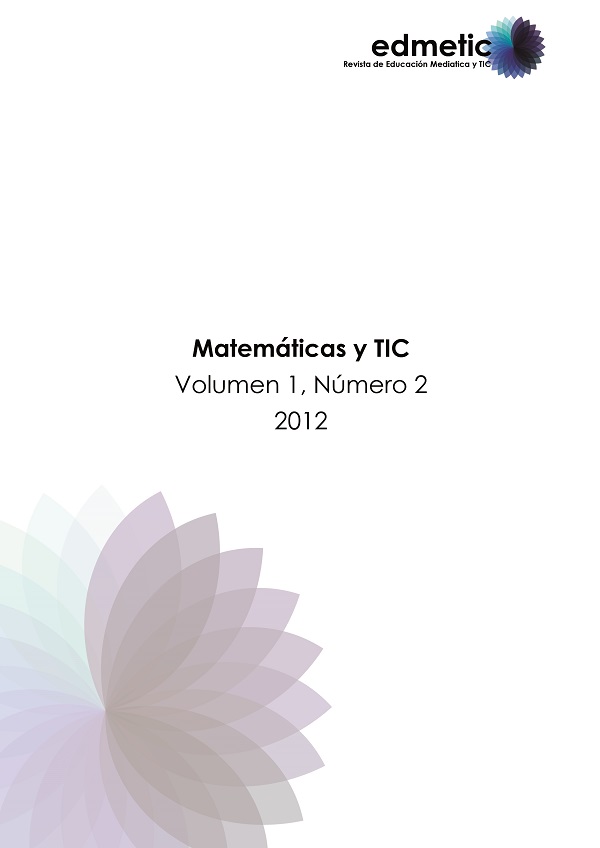Innovación Educativa: Uso de las TIC en la enseñanza de la Matemática Básica
Main Article Content
Abstract
En el artículo se exponen los resultados obtenidos en una experiencia empírica sobre el uso de diferentes recursos tecnológicos en el proceso de enseñanza - aprendizaje de la asignatura Matemática Básica. Para ello se parte de la presentación de una serie de actividades que tienen como objetivo principal motivar la participación y el aprendizaje activo de los estudiantes, además de desarrollar las competencias matemáticas sugeridas en el proyecto PISA.
Downloads
Article Details
TRANSFER RIGHTS AND COMMITMENTS TO EDMETIC, REVISTA DE EDUCACIÓN MEDIÁTICA Y TIC
E-ISSN: 2254-0059
The undersigned author(s) of article entitled:
- Transfer to EDMETIC, Revista de Educación Mediática y TIC publishing rights of the article mention before. The magazine will have the right to publish in any format or media this article.
- The author(s) claim that this article is original and which has not been published before in any format and wasn´t submitted for evaluation to another publication.
- The author(s) claim that this article has the copyright´s permissions for publication
- The author(s) accept the changes to the contents on the review, and changes in the style of the manuscript by the Editorial Board of EDMETIC, Revista Educación Mediática y TIC.
- The author(s) declare that they have complied with the ethical principles of research.
- The author(s) not be subject to personal or business association that involves a conflict of interest with article presented
- El author(s) undertakes to give the primary sources of information, if requested.
Date:
Author(s) names and signatures (1):
(1) Fill the form and send to: revistaedmetic@uco.es
References
ARTZT, A. F. y NEWMAN, C. M. (1997). How to Use Cooperative Learning in the Mathematics Class (2nd edition). Virginia, USA: National Council of Teachers of Mathematics.
CASTAÑO, C., MAIZ, I., PALACIO, G. y VILLARROEL, J. D. (2008). Prácticas educativas en entornos Web 2.0. Madrid: Sintesis.
EDUCASTUR. CONSEJERÍA DE EDUCACIÓN DEL PRINCIPADO DE ASTURIAS (2007). “Web 2.0 y educación”. Recuperado de http://blog.educastur.es/files/2007/06/web2_0v02.pdf.
ERBAS, A. K., LEDFORD, S., POLLY, D. y ORRILL, C.. (2004). Engaging Students through Technology. Mathematics Teaching in the Middle School, 9(6), 300-305.
HODGES, T. y CONNER, E. (2011). Reflections on a Technology-Rich Mathematics Classroom. Mathematics Teacher, 104(6), 432-438.
MARTIN, G. W. (2009). The NCTM High School Curriculum Project: Why It Matters to You. Mathematics Teacher, 103(3), 164–166.
MORENO, F. y SANTIAGO, R. (2003). Formación online. Guía para profesores universitarios. La Rioja: Universidad de la Rioja: REUD, NUTEINCO
NATIONAL COUNCIL OF TEACHERS OF MATHEMATICS (2000). Principles and Standars for school mathematics. Reston, VA: NCTM.
NATIONAL COUNCIL OF TEACHERS OF MATHEMATICS (2008). The Role of Technology in the Teaching and Learning of Mathematics. Position paper. Reston, VA: NCTM. Recuperado de www.nctm.org/about/content.aspx?id=14233.
NISS, M. y JENSEN, T. H. (eds.) (2002). Competencies and the learning of mathematics. Ideas and inspiration for development of mathematics education in Denmark. Copenhagen: The Ministry of Education.
NISS, M. y JENSEN, T. H. (eds.) (2011). Competencies in mathematics education-potentials and challenges. What’s the point? What new? What do we gain? What are the pitfalls? Recuperado de: http://cimm.ucr.ac.cr/ocs/index.php/xiii_ciaem/xiii_ciaem/paper/viewFile/2883/1087.
OECD (2003). The PISA 2003 assessment framework. Mathematics, reading, science and problem solving knowledge and skills. Paris: OECD.
OECD (2004). Learning for tomorrow's world: First results from PISA 2003. Paris: OECD.
PARDO, H. (2007). Nociones básicas alrededor de la WEB. 2.0. (pp. 27-42). En C. Cobo y H. Pardo (eds.). Planeta Web.2.0. Inteligencia colectiva o medios fast food, grup de Recerca dínteraccions digitals. Barcelona-México: Univers Vic/Flasco.
